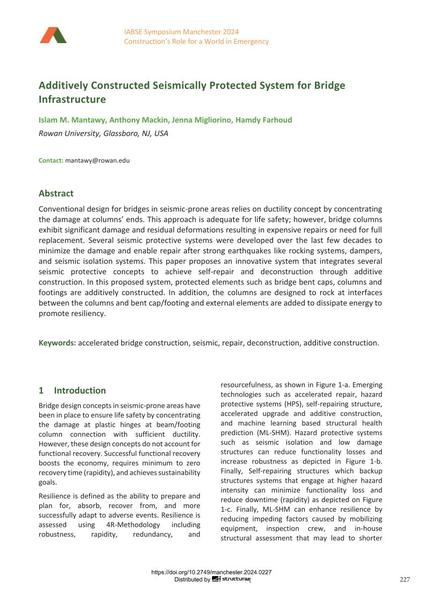Additively Constructed Seismically Protected System for Bridge Infrastructure

|
|
|||||||||||
Détails bibliographiques
| Auteur(s): |
Islam M. Mantawy
(Rowan University, Glassboro, NJ, USA)
Anthony Mackin (Rowan University, Glassboro, NJ, USA) Jenna Migliorino (Rowan University, Glassboro, NJ, USA) Hamdy Farhoud (Rowan University, Glassboro, NJ, USA) |
||||
|---|---|---|---|---|---|
| Médium: | papier de conférence | ||||
| Langue(s): | anglais | ||||
| Conférence: | IABSE Symposium: Construction’s Role for a World in Emergency, Manchester, United Kingdom, 10-14 April 2024 | ||||
| Publié dans: | IABSE Symposium Manchester 2024 | ||||
|
|||||
| Page(s): | 227-234 | ||||
| Nombre total de pages (du PDF): | 8 | ||||
| DOI: | 10.2749/manchester.2024.0227 | ||||
| Abstrait: |
Conventional design for bridges in seismic-prone areas relies on ductility concept by concentrating the damage at columns’ ends. This approach is adequate for life safety; however, bridge columns exhibit significant damage and residual deformations resulting in expensive repairs or need for full replacement. Several seismic protective systems were developed over the last few decades to minimize the damage and enable repair after strong earthquakes like rocking systems, dampers, and seismic isolation systems. This paper proposes an innovative system that integrates several seismic protective concepts to achieve self-repair and deconstruction through additive construction. In this proposed system, protected elements such as bridge bent caps, columns and footings are additively constructed. In addition, the columns are designed to rock at interfaces between the columns and bent cap/footing and external elements are added to dissipate energy to promote resiliency. |
||||
